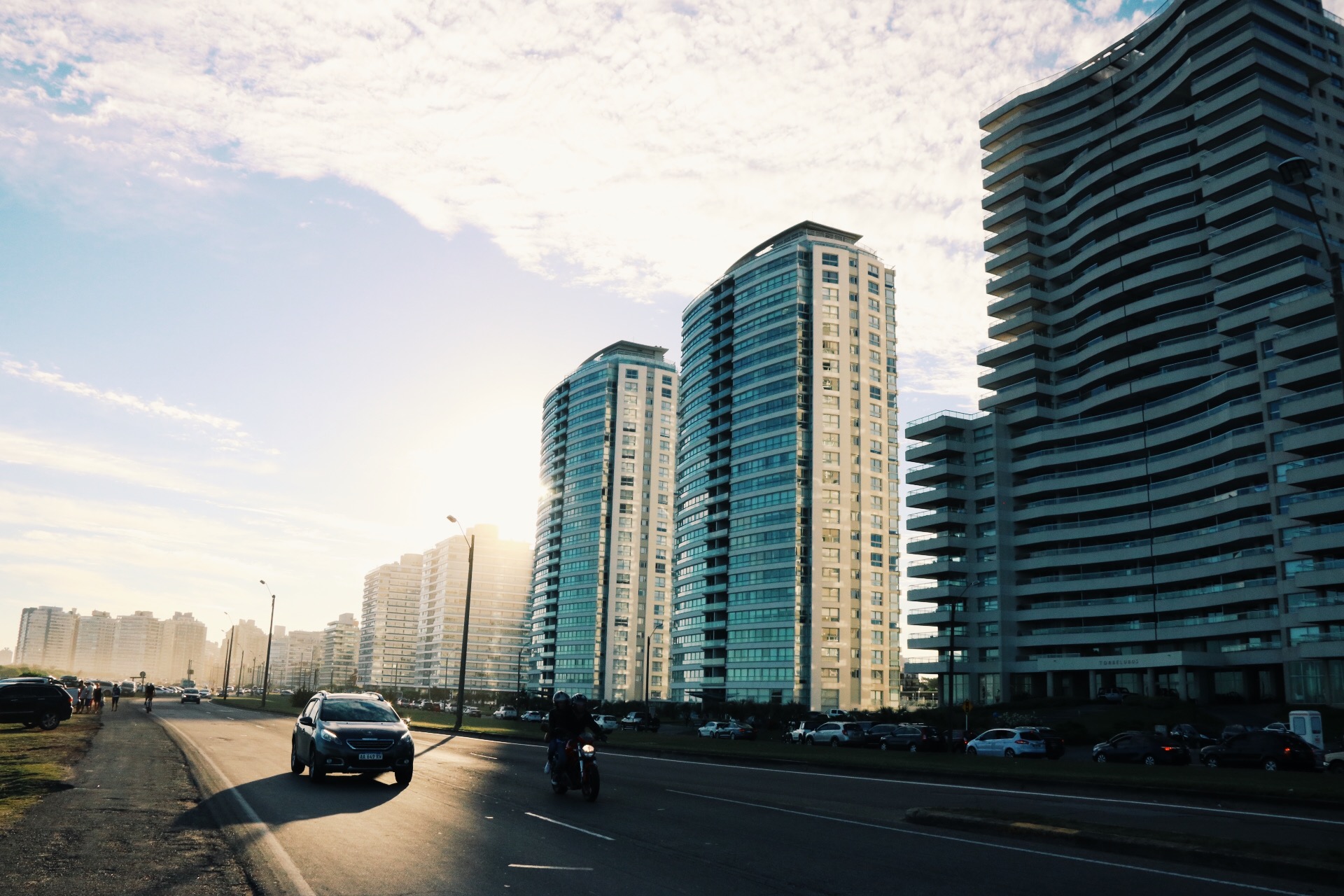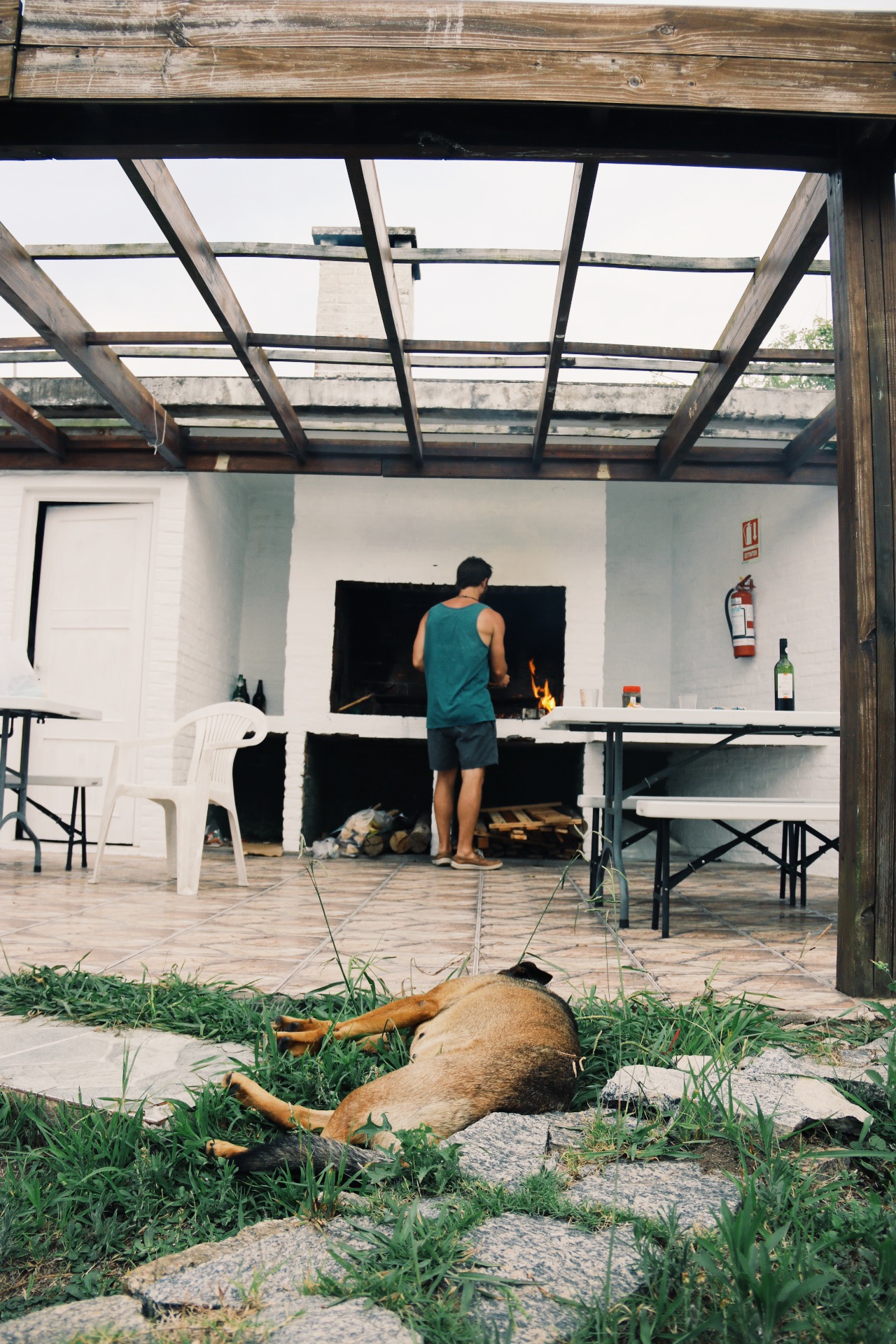The Uruguayan Coast
We boarded a bus out of the city and headed toward Punta Del Este. This coastline was not only a huge mystery to us, but this entire country was also practically unknown, completely foreign, and almost completely off of the radar of Americans.
High-rise condos line the coastal town of Punta del Este.
Our first stop was outside of the major coastal town (which is described as the "Mykonos" of South America), Punta del Este. We had seen photos of sleek white buildings perched on a rocky beach, but this was a mere corner of a town clad with high-end steak houses, chic high-rise condos, and wealthy South American families indulging in pizza and helados.
Of course, we had chosen to be in this town during the busiest, most expensive, touristic "Super Month" of the year, raising most all of prices at least 30%. This resulted in us having to stay our first three nights in dorm-type hostels (approximately $56US per night for the two of us), where the rooms were lined with bunk beds with mattresses wrapped in plastic (imagine 8-12 people tossing and turning in the night, and us having an air-conditioning battle with these South Americans who thought they were going to freeze to death). Despite all of this, we were in awe of the beauty of the beaches and star-struck by the prosperity of the people and their homes. We tanned, shopped at all of the fresh markets, and rode bicycles all around the town. It took all of the savvy we had to not go more than $20US over our generous $90US per day budget for just the bare bones.
Nonetheless, we loved the city and could not stop talking about how we want to bring our own families back for a vacation and experience of their own.
We were surprised that Trump is building a new condo tower here.
One of many large homes.
Feeling like a match made in heaven.
Eating home-cooked meals at our hostel.
Grilling up our own dinner on the Parrilla.
Trevor, the Parrilla Master.
The next stop was Manantiales, home of Bikini Beach and just outside of the main city of Punta. We found our home this time at the rustic El Hostalito.
The accommodations there were quaint and minimal, however, it was the community and sense of family and comfort that made this hostel one we will never forget. Every night, the owner, his wife, and some friends would put together the freshest meals that are truly reminiscent of being back home. The first night was Parrilla night, where we were fed large plates of grilled chorizo, beef, veggies, and fresh salsas to dip. The next night was all about pizza, where they custom topped homemade dough with an array of fresh fixin's and fired it up in their pizza oven. We felt so much a part of this family, although our Spanish lacked and we were there for such a short time.
Giving Maia a braid.
Pizza night
About to eat some fresh fruit for lunch.
Trevor hanging out with baby Luca.
Bikini Beach in Manantiales, without a doubt, matches its name. Most women (no matter what age, shape, or size) can be seen there in the tiniest thong bikinis smoking cigarettes, browning their already dark skin, and sipping Yerba mate. It was the best place to chill, people watch, and take dips in the refreshingly cool ocean. As the sun sets there every day, the entire beach would applaud, and the surfers would try and catch their last waves.
Lifeguards watching over the crowded beach.
The sand was covered in these beautiful shells.
Surfing until dark.
Salty Eyelashes
An Applause for another beautiful sunset.
Next, we had a one night stay in La Paloma, a surf town that was about four hours (of getting on and off buses and waiting for late buses) north of Manantiales. It's a sleepy town, with a laid back vibe, very few over-priced restaurants, and the perfect waves for beginner surfers. This was a very short stop for us, but would be a great one for anyone seeking a few lazy beach days.
Our last stop up the Uruguayan coast was Punta Del Diablo. This isolated part of the coast is an old fishing village, turned into a beach town where hippies make their seasonal pilgrimage. There you will find the longest dreadlocks, every type of handmade jewelry, and the softest, sandy-est beaches around. The rocky cliffs are scattered with homes that look more like shanties where the hippies congregate to smoke weed legally and squat for the night. There, the waves chronically pound the rocks, as if to tease the homes of some impending doom. We loved to find a place to sit each evening to watch the water and enjoy a naturally-made acai bowl.
A refreshing Acai Bowl
The amazing Diablo Sunset
Exploring graffiti ruins on the Diablo beach.
The main Beach in Punta del Diablo.
Coastal love.
We scored two nights at Hostel de las Hadas, which provided a newly built room in a treehouse-looking bungalow. The owner is from Spain and cooked an amazing "paella" con frutas Del Mar (a mix of seafood) for Sunday night dinner. He told us, "If you like it, you can pay for it. If you don't like it, you don't have to pay for it. And if it's the best you ever had, you can give me one extra peso!" (By the way, currently it is $28.6 Uruguayan pesos to $1US dollar). We laughed, and it happened to be amazing, so we threw him a bit more than one peso.
The common area in Hostel de las Hadas.
The rocky beach of Punta Del Diablo
Enjoying the view.
Overall, this coastal trip was one to write home about. Trevor and I found ourselves constantly daydreaming of coming back for a shorter amount of time with family and a larger budget. We weren't able to go out and drink and party like a lot of people do here, but we definitely plan on adding that to our list.
Windy days in Diablo.
We hope you all are healthy, safe, and making memories! Until next time!
-Bree and Trevor





























